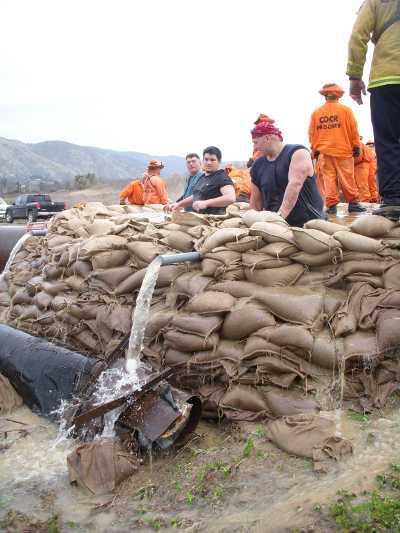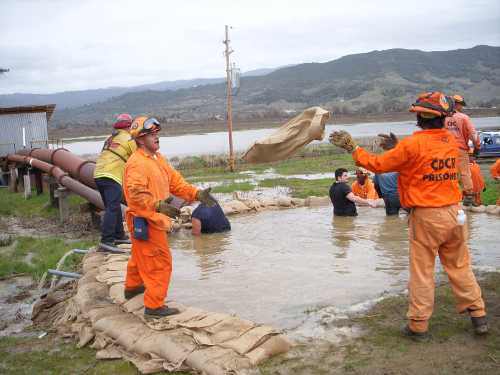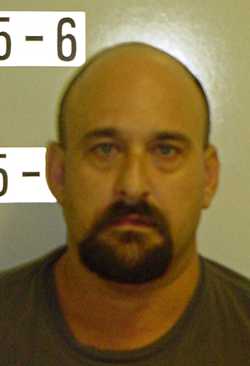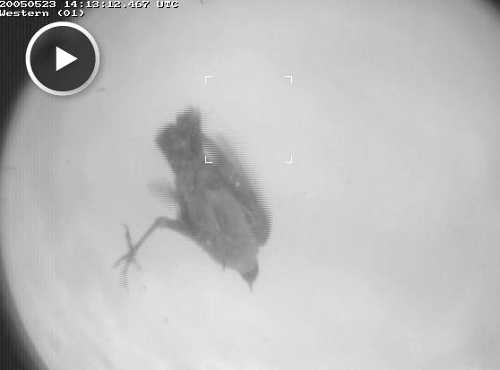
Meyer lemons have a delicate flavor, and seem available for only a short time in the year. Photo by Esther Oertel.
I had an entirely different subject on which I was going to expound this weekend; however, a recent trip to my local market changed all that.
There, in my line of sight as I entered the doors, was a pile of local Meyer lemons. I long for these year round, making it a cause for celebration whenever they’re available.
Maybe it’s me, but it feels like their season is here for just a few minutes each year, and I try to take advantage of every second of it.
Meyer lemons have a more delicate flavor than typical supermarket lemons, which is why I love them so much. They’re not as hardy in terms of shelf life, so – at least in my neck of the woods – they make a brief appearance when local growers have them available, which, depending on the characteristics of the season, can be any time between December and March.
Trees can produce year round, but the majority of the crop arrives in winter. If you have a Meyer lemon tree, or a generous neighbor with one, you are blessed indeed.
The Meyer lemon originated in China and is thought to be a cross between a true lemon and either a Mandarin or common orange.
They were introduced to the U.S. in 1908 by Frank Meyer, an agricultural explorer who was employed by the U.S. Department of Agriculture; hence the name Meyer lemon.
The fruit is yellower and rounder than a true lemon, even leaning toward a pale orange tone in some cases. Their flesh is sweeter and less acidic than the Lisbon or Eureka lemons commonly found in stores.
Though they’ve been cultivated in the U.S. since just after the turn of the last century, it wasn’t until the California cuisine revolution (beginning in the 1970s and inspired by such chefs as Alice Waters of Chez Panisse in Berkeley) that they became popular in cuisine. Martha Stewart further popularized them through her use of them in recipes.
The more acidic cousins of Meyer lemons work better in some recipes. Hollandaise sauce, for example, doesn’t contain enough of its characteristic tartness if Meyer lemons are used. However, other than a few exceptions, I prefer the gentleness of Meyer lemons in almost every culinary application.
One of my favorite things to do when they’re in season is make lemon curd, a fruit spread that’s popular in the United Kingdom. Traditionally used on scones, breads and cookies, it can also be a base for lemon meringue pie or a filling for tarts.
Jars of homemade lemon curd make fantastic Christmas gifts, but I recommend making double batches so some will survive enthusiastic tasting during the cooking process.
I made my first homemade batch a couple of years ago in preparation for an English tea culinary class and have been addicted to its sweet-tart creamy goodness since then.
It contains just four ingredients – butter, sugar, eggs and lemon (using both the fresh juice and zest) – but don’t be fooled by its simplicity.
The gentle tartness from Meyer lemons, sweetness from sugar, and richness from butter and eggs combines to form a pleasingly balanced taste. And the plethora of zest adds nice texture.
Meyer lemons are a wonderful match for Moroccan cuisine, where they’re used in chicken and lamb dishes, salads and desserts.
Lemons are quite popular in Morocco, where, among other things, they’re pickled (preserved in salt) as a means to keep them without refrigeration.
Many Moroccan recipes call for such preserved lemons, which add an intense salty-tangy taste to traditional dishes there.
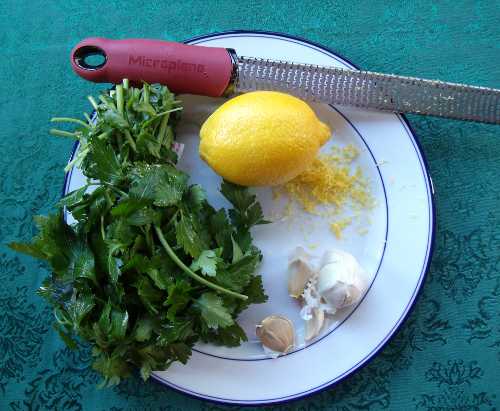
Lemon zest, garlic and fresh parsley are the three components needed to make gremolata, a condiment that originated in Italy. Photo by Esther Oertel.
Preserved lemons are sometimes sold in specialty stores, where they can be very expensive. I once bought a jar for close to $7 which contained only two preserved lemons. (Foolish, yes, but I needed them for a class.)
They can be made cheaply and easily at home, a perfect use for the wonderful Meyer lemons available seasonally. It takes time for the flavor to develop, but the effort is well worth it.
You’ll need sterilized glass jars, lemons, salt (additive-free kosher salt is recommended), time, and lots of patience.
Wash the lemons and make four deep lengthwise cuts that divide it into four sections while keeping the lemon whole. (It should be attached at the end.)
Pack the cuts generously with salt. Put a couple tablespoons of salt in the bottom of a glass jar and pack the lemons in layers, spreading a thin layer of salt between each layer of lemons.
Push the lemons down firmly to pack them tightly and to express some of their juice. Finish with a final layer of salt.
Cover the jar tightly and leave at room temperature for a few days, monitoring the level of liquid in the jar. Because the salt draws out their juices, the lemons should be submerged after a few days. If they’re not, add more lemon juice.
They should be ready to eat within a few weeks and will keep for up to a year. The flavor develops as they age; in fact, they should be heavenly by the sixth month.
They don’t require refrigeration, but I store them there after the first few weeks.
In addition to using preserved lemons in Moroccan food, wedges of them may be tossed into the cooking water of rice or couscous in place of salt, paper thin slices of them can garnish a pizza, and their flavor can enhance grain salads or tomato dishes.
Lemon is often paired with lavender, and Meyer lemons make an especially pleasant match. Lavender scones may be topped with lemon curd, for example, or lavender-infused syrup may be used to sweeten lemonade.
The time to preserve or use Meyer lemons is the moment you see them available at your local grocer, farmers’ market, or tree. If nothing else, zest and juice them immediately.
The juice may be frozen in ice cube trays and then stored in zipper sealed bags in the freezer until used.
The thin, yellow outer skin – also known as the zest – may be grated and left to dry on sheets of waxed paper. Once dried, it may be stored, like the juice cubes, in the freezer in zipper sealed bags.
Lemon butter may be made by blending fresh juice and zest with softened butter at room temperature, either by hand or in a food processor.
Use immediately, store in the fridge, or freeze by making lemon-butter logs. (This is done by rolling the butter into logs in waxed paper and storing in freezer bags, either whole or sliced into medallions.)
Or simply enjoy these fragrant lemons now, as they are, squeezed over a piece of fish or lightly steamed vegetables, with honey in tea, or baked into muffins, breads, or cakes.
Whatever you do, breathe deeply of their sweet scent and enjoy these fleeting moments when Meyer lemons abound.
Today’s recipe is gremolata (sometimes spelled gremolada), a bright and lively condiment made with parsley, garlic, and lemon zest that originated in Italy. It’s traditionally served as a garnish for a braised veal shank dish native to Milan known as osso buco, but is delicious on many foods, including fish, poultry, pasta, vegetables and roasted potatoes.
Gremolata always includes grated lemon peel, but beyond that there is considerable variation. The most common recipes include parsley and garlic; however, mint, anchovies, rosemary, or sage may sometimes be added.
Here is my version, which may be used to garnish any dish to which you’d like to add a burst of citrusy flavor. It’s especially good for lightening up hearty, heavy dishes. Enjoy!
Gremolata
¼ cup finely chopped Italian flat-leaf parsley
3 garlic cloves, finely chopped
Grated zest of one fresh lemon
Combine all ingredients in a small bowl an hour or so before you plan to serve it so the flavors combine nicely. It’s best made fresh and will keep up to a day in the fridge.
Follow Lake County News on Twitter at http://twitter.com/LakeCoNews , on Facebook at http://www.facebook.com/pages/Lake-County-News/143156775604?ref=mf and on YouTube at http://www.youtube.com/user/LakeCoNews .

 How to resolve AdBlock issue?
How to resolve AdBlock issue? 
